King Tut's mummy on display for 1st time

The linen wrapped mummy of King Tut was put on public display for the first time yesterday - 85 years after the 3,000-year-old boy pharaoh's golden enshrined tomb and mummy were discovered in Luxor's famed Valley of the Kings.
Archeologists removed the mummy from his stone sarcophagus in his underground tomb, revealing his shriveled leather-like face and body.
"The golden boy has magic and mystery and therefore every person all over the world will see what Egypt is doing to preserve the golden boy, and all of them I am sure will come to see the golden boy," Egypt's antiquities chief Zahi Hawass told reporters under the intense Luxor sun.
Hawass said scientists began restoring King Tut's badly damaged mummy more than two years ago after it was removed briefly from its sarcophagus and placed into a CT scanner for the first time for further examination. Much of the mummy's body is broken into 18 pieces that Hawass described looked like stones that were damaged when British archaeologist Howard Carter discovered the mummy, took it from his tomb and tried to pull off his famous golden mask.
But Hawass said he fears a more recent phenomenon - mass tourism - is further deteriorating Tut's mummy. Thousands of tourists visit the underground chamber every month.
The mystery surrounding King Tutankhamun and his glittering gold tomb has entranced ancient Egypt fans since Carter first discovered the hidden tomb on November 4, 1922, revealing a trove of fabulous gold and precious stone treasures.
Archeologists in recent years have tried to resolve lingering questions over how he died and his precise royal lineage. Several books and documentaries dedicated to the young pharaoh, who is believed to have been the 12th ruler of ancient Egypt's 18th dynasty and ascended to the throne around the age of 8, are popular around the world.
In an effort to try to solve the mysteries, scientists removed Tut's mummy from his tomb and placed it into a portable CT scanner for 15 minutes in 2005 to obtain a three-dimensional image. The scans were the first done on an Egyptian mummy.
The results did rule out that Tut was violently murdered - but stopped short of definitively concluding how he died around 1323 B.C. Experts for the time though suggested that days before dying, Tut badly broke his left thigh, apparently in an accident that may have caused a fatal infection.
Agencies
(China Daily 11/05/2007 page6)














